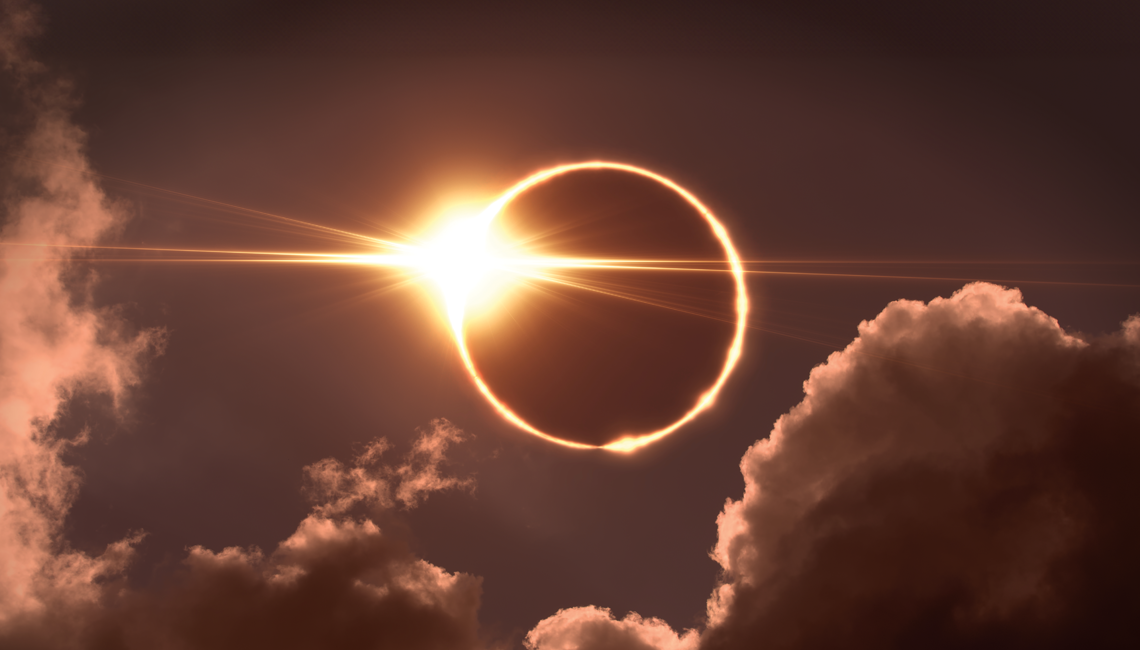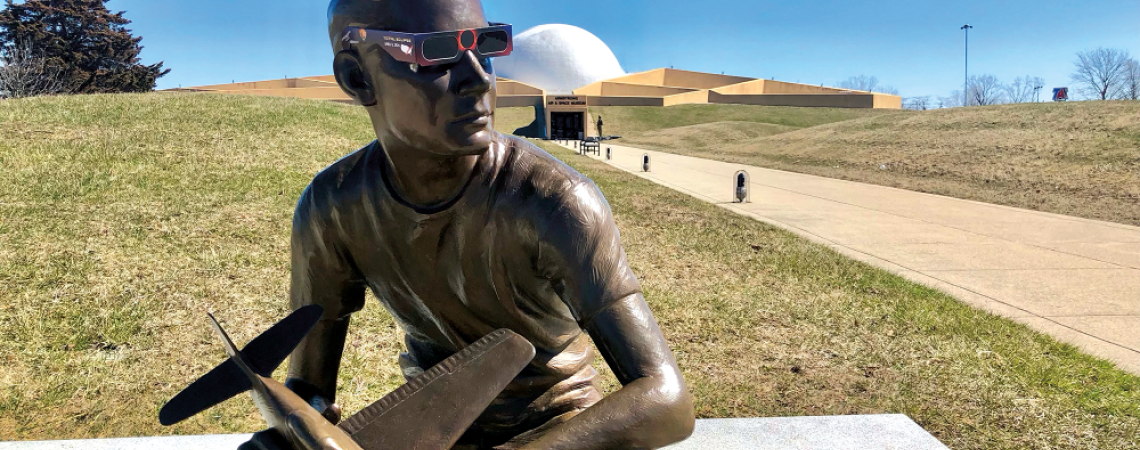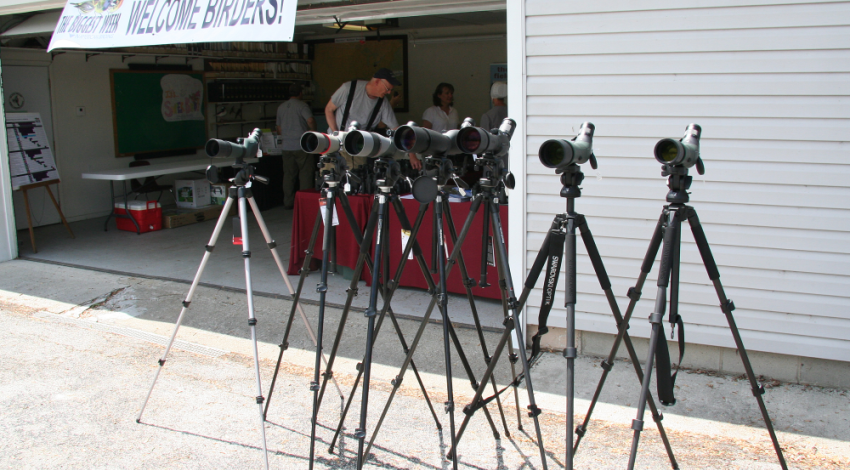On April 8, the moon’s orbit will place it directly between Earth and the sun, casting nightlike darkness on a path starting in the South Pacific at about 11:42 a.m. Eastern time and ending about five hours later somewhere over the North Atlantic. The 100-mile-wide path of totality (where the event will be seen as a total eclipse) goes directly across Ohio — darkening Dayton, blacking out Bowling Green, enshadowing Chardon. In the center of that path, the total eclipse will last for nearly four minutes.
The first bits of the partial eclipse will be seen — weather permitting, it should be stressed — in the town of Harrison, in Hamilton County, seconds before 1:52 p.m., and be last visible in Conneaut at the extreme northeastern tip just past 4:31 p.m. Following are a few ideas for some spectacular viewing around the state. Don’t miss out; the next total eclipse visible in Ohio won’t happen until 2099.
From moonwalk to sun dance
On July 20, 1969, every eye in Wapakoneta (and, of course, around the world) was fixed on the sky. The tiny city’s native son, Neil Armstrong, was up there, making his “one small step for a man, one giant leap for mankind.”
Next month, on April 8, 2024, to be exact, all eyes again will be gazing moonward — albeit this time with safety shades in place — for another astronomical event of historic significance, and Wapakoneta, like cities and towns across Ohio and all over North America, is over the moon with excitement.
Chas Fagan’s bronze statue of 15-year-old Neil Armstrong — ready for the eclipse (photo courtesy of the Armstrong Air and Space Museum).
For the first time since Ohio’s infancy, the Buckeye State is in the path of a total eclipse of the sun, and Wapakoneta is almost directly in the center of that path. Viewers there will see the beginning of the eclipse shortly before 2 p.m., experience totality for nearly four minutes a little after 3 p.m. (with the maximum at 3:11 p.m.), and then watch it as partial again until about 4:25 p.m.
Those two and a half hours will be the climax of a weekend full of celebration as Wapak, along with cities, towns, parks, businesses, and private citizens across the state, is preparing for an onslaught of visitors. “The last one in this area was in 1806,” says Logan Rex, curator of the Armstrong Air and Space Museum in Wapakoneta. “Who’s going to come and watch the sun for four minutes? Probably a million people will.”
April 8 is a Monday, and while Ohio is just one of the 13 U.S. states where people can see it in totality, Wapakoneta — being the hometown of the moon’s most famous visitor — takes special pride in planning a busy weekend full of events to mark the occasion. “Wapakoneta is not only a prime location to witness this cosmic phenomenon but also an ideal destination to celebrate the celestial spectacle,” says Jackie Martel, executive director of the Wapakoneta Area Chamber of Commerce.
Armstrong museum officials began preparing for the event nearly eight years ago, when officials traveled to Missouri to witness the August 2017 solar eclipse there and see how towns and other entities reacted. “The No. 1 consistent thing we learned was: Do not run out of solar eclipse glasses,” Rex says. “There were a couple of places that did, and it was borderline mutiny.”
Rex expects up to 35,000 people to descend upon Wapakoneta over the eclipse weekend, and the Armstrong museum is a natural landing spot for visitors. Plans there include multiple tours, educational events, and outdoor concession vendors, as well as an extensive selection of eclipse-related merchandise — including an ample supply of eclipse-viewing safety glasses — in the museum gift shop.
“It’s a great blessing,” Rex says, “that this great, astronomical event is going over our museum dedicated to the moon.”
If you go to Wapakoneta
While the Neil Armstrong museum may be the epicenter of Wapakoneta’s eclipse celebration, it’s not just the museum that’s abuzz with the event. Businesses around the city and Auglaize County and others are planning a cluster of special events, including:
- A four-day Eclipse Festival at the Auglaize County Fairgrounds with live music, food trucks, a vendor market, and special family activities.
- Live music parties at local businesses and event centers.
- Guided bus tours of “Wapakoneta as Neil Armstrong Knew It.”
- A celestial psychic fair.
- A space-themed film festival at the historic Wapa Theatre.
- A special “eclipse sermon” at St. Paul United Church of Christ, Armstrong’s church, on the Sunday before the eclipse.
- Riverside Art Center in downtown Wapakoneta is selling a collection of T-shirts and other eclipse memorabilia.
- The Neil Armstrong Airport in New Knoxville plans to roll out the red carpet to flyers and their passengers to hang out and watch the eclipse. Manager Tom Bergstrom says there will be on-pavement parking spaces for about 70 aircraft, with a food truck, DJ, and other activities, although the airport will be closed to vehicular traffic.
More events can be found at www.wapaksolareclipse.com, an eclipse information website maintained by the chamber, which lists event schedules, accommodations, and even a local restaurant “Moon Menu Trail,” offering eclipse-themed specials.
How to safely watch a solar eclipse:
- Carefully look at your solar filter or eclipse glasses before using them. If you see any scratches or damage, do not use them.
- Always read and follow all directions that come with the solar filter or eclipse glasses. Help children to be sure they use handheld solar viewers and eclipse glasses correctly.
- Before looking up at the bright sun, stand still and cover your eyes with your eclipse glasses or solar viewer. After glancing at the sun, turn away and remove your filter — do not remove it while looking at the sun.
- The only time that you can look at the sun without a solar viewer is during a total eclipse. When the moon completely covers the sun’s bright face and it suddenly gets dark, you can remove your solar filter to watch this unique experience. Then, as soon as the bright sun begins to reappear very slightly, immediately use your solar viewer again to watch the remaining partial phase of the eclipse.
- Never look at the uneclipsed or partially eclipsed sun through an unfiltered camera, telescope, binoculars, or other similar devices. This is important even if you are wearing eclipse glasses or holding a solar viewer at the same time. The intense solar rays coming through these devices will damage the solar filter and your eyes.
- Talk with an expert astronomer if you want to use a special solar filter with a camera, a telescope, binoculars, or any other optical device.










